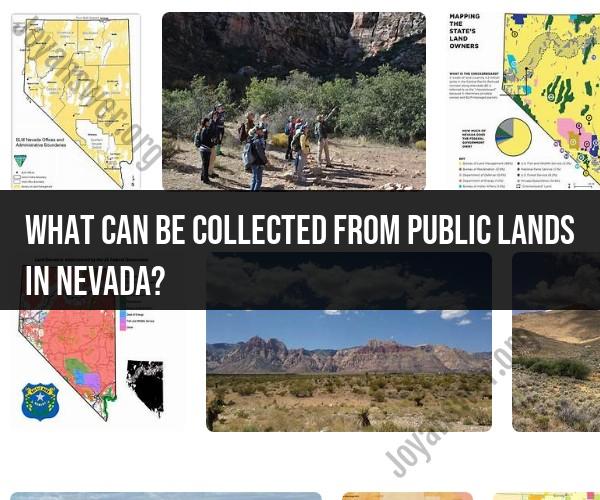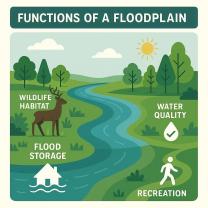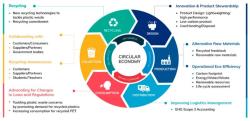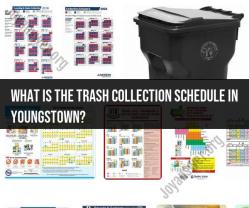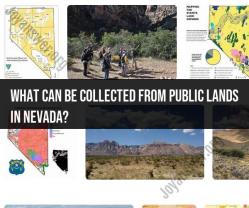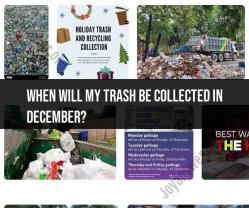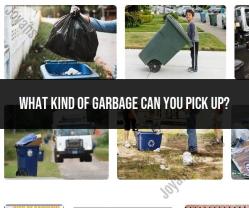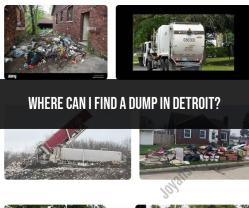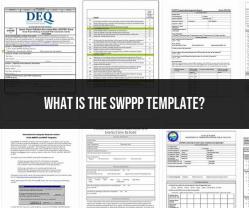What can be collected from public lands in Nevada?
Collecting resources from public lands in Nevada, like other parts of the United States, is subject to regulations and guidelines to protect the environment and preserve these lands for future generations. The types of resources you can collect, and the rules governing their collection, may vary depending on the specific land management agency overseeing the area (e.g., the Bureau of Land Management, U.S. Forest Service, National Park Service). Here are some general guidelines and considerations:
Rocks and Minerals:
- Collecting rocks and minerals for personal use is generally allowed on many public lands in Nevada. However, certain areas, such as national parks and wilderness areas, may have restrictions.
- Commercial collection or the removal of significant quantities of rocks and minerals may require permits.
Fossils:
- The collection of fossils is regulated on public lands. Removing fossils is usually prohibited in national parks and protected areas.
- On some lands, you may be allowed to collect common invertebrate fossils for personal use, but vertebrate fossils are often protected by federal law.
Plants and Wildflowers:
- Harvesting plants, including wildflowers, for personal use is generally allowed in many areas. However, the removal of rare, threatened, or endangered plant species is prohibited.
- Always check with the land management agency for specific regulations on plant collection in a particular area.
Mushrooms:
- Mushroom collecting is allowed for personal use on many public lands in Nevada. However, regulations and seasons may apply.
- Commercial mushroom harvesting often requires a permit.
Firewood:
- Some public lands may allow the collection of dead and downed wood for personal use. Regulations may specify the type and quantity of wood that can be collected.
- Cutting live trees or shrubs is generally prohibited.
Wildlife and Animal Products:
- The collection of wildlife, animal parts, and animal products is heavily regulated and often prohibited.
- Hunting, trapping, and fishing are regulated by state wildlife agencies, and permits/licenses are required.
Artifacts and Archaeological Resources:
- Removing artifacts, petroglyphs, or archaeological resources from public lands is illegal. These items are protected by federal laws, including the Archaeological Resources Protection Act (ARPA).
Recreational Activities:
- Public lands in Nevada offer opportunities for various recreational activities, such as hiking, camping, and photography. These activities do not involve resource collection and are generally encouraged.
Permits and Regulations:
- Always check with the specific land management agency responsible for the area you intend to visit to understand the rules and regulations governing resource collection. Regulations can vary widely between different land management agencies and locations.
Leave No Trace Principles:
- Regardless of the type of resource you collect, it's essential to follow Leave No Trace principles, which promote responsible outdoor ethics and minimal impact on the environment.
Remember that regulations and policies may change, so it's crucial to stay informed and respect the rules in place to protect public lands and their natural and cultural resources. Violating these regulations can result in fines, legal consequences, or harm to the environment and cultural heritage. Always prioritize conservation and responsible resource use when visiting public lands in Nevada or elsewhere.
Public Lands in Nevada: What Can You Collect?
There are a variety of things that you can collect on Nevada's public lands, but it is important to check the rules and regulations before you start collecting. The Bureau of Land Management (BLM) manages the majority of public lands in Nevada, and they have a set of rules for collecting on public lands.
In general, you can collect the following items on public lands in Nevada:
- Flowers, berries, nuts, seeds, cones, and other plant parts
- Campfire wood
- Rocks, mineral specimens, common invertebrate fossils, and semiprecious gemstones
You are not allowed to collect the following items on public lands in Nevada:
- Archaeological artifacts
- Historical objects
- Native American artifacts
- Threatened or endangered plants or animals
- Any item that is more than 25% of the original size of the plant or animal
Exploring Collectibles on Nevada's Public Lands
Nevada is a great state for collecting, with a wide variety of plants, minerals, and other items to collect. Here are a few ideas for things to collect on Nevada's public lands:
- Rocks and minerals: Nevada is home to a variety of rocks and minerals, including gold, silver, obsidian, and turquoise. You can collect rocks and minerals for personal use, but you are not allowed to sell them.
- Fossils: Nevada is also a great place to find fossils. You can find fossils of dinosaurs, marine animals, and plants. Be sure to check the rules and regulations before you start collecting fossils, as there are some areas where collecting fossils is prohibited.
- Wildflowers: Nevada has a variety of wildflowers that bloom throughout the year. You can collect wildflowers for personal use, but you are not allowed to sell them.
- Berries and nuts: Nevada has a variety of berries and nuts that you can collect for personal use. Be sure to identify the plants carefully before you collect them, as some poisonous plants look similar to edible plants.
Responsible Collecting Practices on Nevada's Public Lands
When collecting on Nevada's public lands, it is important to follow responsible collecting practices. Here are a few tips:
- Only collect what you need: Don't over-collect. Take only what you need for personal use.
- Leave no trace: Leave the area as you found it. Pack out all of your trash and leave no sign of your visit.
- Respect wildlife: Don't disturb wildlife or their habitat.
- Be aware of the rules and regulations: Check the rules and regulations before you start collecting. Some areas have special restrictions on collecting.
By following these tips, you can help to ensure that Nevada's public lands remain available for future generations to enjoy.
